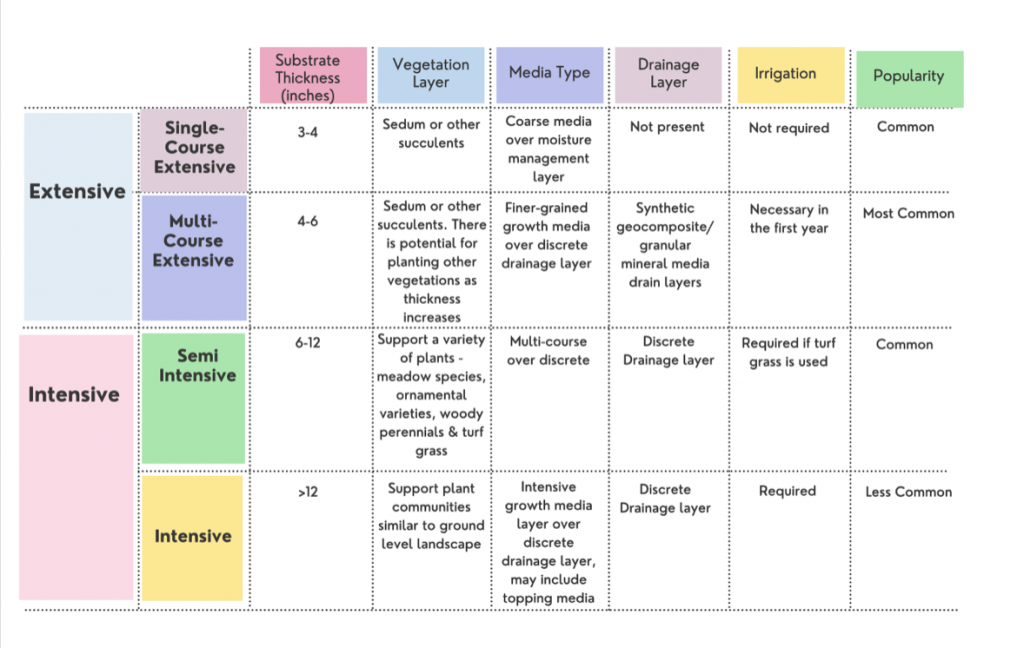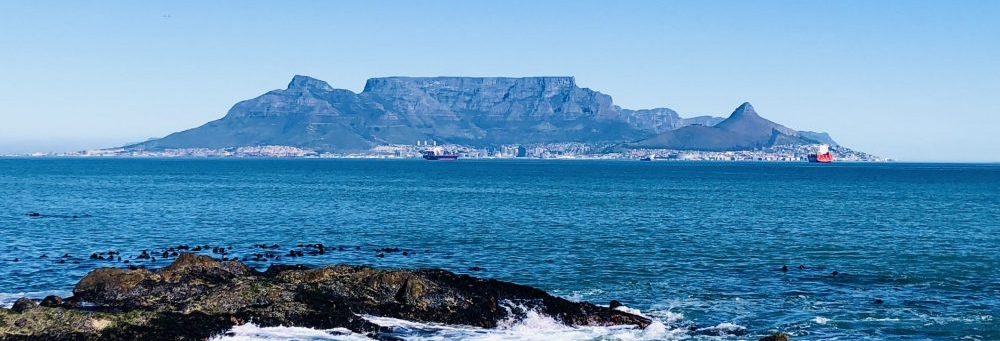The green roof is roof planted with vegetation on top of the growth medium (substrate). The green roof is an example of green infrastructure/Low Impact Development that is both a structural component of a building and a source control measure for stormwater management. Green roofs can provide many environmental benefits in urban settings to help mitigate the effect of the urbanization, such as the ability to retain and detain stormwater (Villarreal & Bengtsson, 2005), improve wildlife habitats for more biodiversity (Emilsson et al., 2007; GSA. US, 2011), reduce the urban heat island effect, enhance the air and water quality and reduce the energy consumption costs of the buildings (del Barrio, 1998; GSA. US, 2011; Vijayaraghavan et al., 2012).

The Green roof Design Features
There are two main types of green roofs which are extensive green roofs and intensive green roofs, and they are categorized based on the substrate thickness, where the extensive green roof has a thinner layer with a substrate thickness of less than 6 inches, while the intensive green roof has a thicker layer with substrate thickness more than 6 inches (GSA. US, 2011; Shafique et al., 2018).
Cross-section of a green roof

Infographics for the green roof components



Many people have the misconception that the green roof does not require irrigation, fertilization and that no weed growth would occur on the green roof (Vijayaraghavan, 2016). These untrue claims are mostly from the commercial developers of the green roof to motivate their clients in purchasing their products. Nevertheless, green roofs do require irrigation during drought climates and need regular checks in terms of drainage and weed removal. The intensive green roof requires more detailed maintenance operations than the extensive green roof due to its thicker substrate and a greater variety of plant species.
After the design and installation phases of the green roof systems, maintenance is a crucial step in the process because it affects the system’s performance and longevity. Temperature and climate play a significant role in terms of the operation and maintenance scheme of the green roof systems. For countries with a tropical climate, it may be required to have a regular irrigation regime for their constructed green roofs (Luckett, 2009; Saharuddin et al., 2020). In addition, a lack of knowledge in the operation and maintenance of the green roof would also result in issues of leakages, the presence of invasive species, mould growth, and water ponding, which would shorten the lifespan of the green roof and cause additional problems (Ismail et al., 2012). According to their poll, more than 97 percent of respondents concur that maintaining a green roof is challenging and time-consuming. The authors also claim that leaks on green roofs are difficult to detect and expensive to repair (Ismail et al., 2012). Saharuddin et al. (2020) evaluated various maintenance strategies for the green roof and they concluded the most significant criteria to be looked into when maintaining the green roof is drainage, followed by waterproofing, irrigation, water retention, roof slab, insulation, soil substrate, vegetation, safety, roof access, roof, fertilization, pest and disease control, debris removal, pruning, and weed control.
Reference
Carter, T., & Jackson, C. R. (2007). Vegetated roofs for stormwater management at multiple spatial scales. Landscape and Urban Planning, 80(1–2), 84–94. https://doi.org/10.1016/j.landurbplan.2006.06.005
Villarreal, E. L., & Bengtsson, L. (2005). Carter. Ecological Engineering, 25, 1–7.
Emilsson, T., Berndtsson, J. C., Mattsson, J. E., & Rolf, K. (2007). Effect of using conventional and controlled release fertilizer on nutrient runoff from various vegetated roof systems. Ecological Engineering, 29, 260–271.
GSA. US. (2011). The Benefits and Challenges of Green Roofs on Public and Commercial Buildings. A Report of the United States General Service Administration; 2011. [A Report of the United States General Service Administration].
del Barrio, E. P. (1998). Analysis of green roofs cooling potential in buildings. Energy and Buildings, 27, 179–193.
Vijayaraghavan, K., Joshi, U. M., & Balasubramanian, R. (2012). A field study to evaluate runoff quality from green roofs. Water Research, 46(4), 1337–1345. https://doi.org/10.1016/j.watres.2011.12.050
Luckett, K. (2009). Green Roof Construction and Maintenance (GreenSource Books). McGraw-Hill Professional Publishing. http://ebookcentral.proquest.com/lib/ubc/detail.action?docID=4657557.
Saharuddin, S., Khalil, N., & Abdullah Saleh, A. (2020). PRIORITISING CRITERIA OF MAINTENANCE FOR GREEN ROOF IN HIGH-RISE RESIDENTIALS. Journal of Surveying, Construction & Property, 11(2), 27–39. https://doi.org/10.22452/jscp.sp2020no1.3
Ismail, Z., Aziz, H., Nasir, N. M., Zafrullah, M., Taib, M., & Alam, S. (2012). Obstacles to Adopt Green Roof in Malaysia. 357–361


